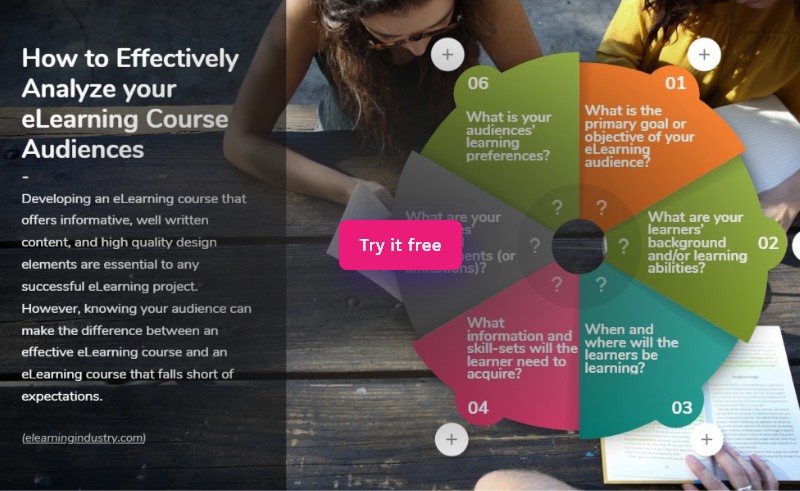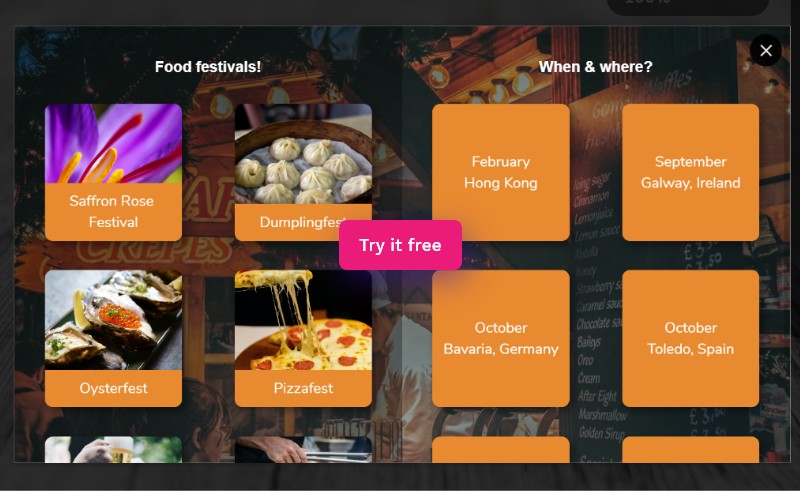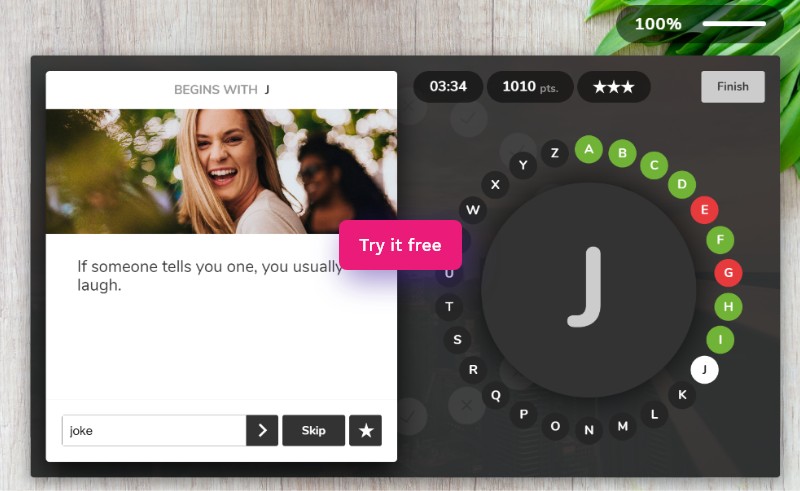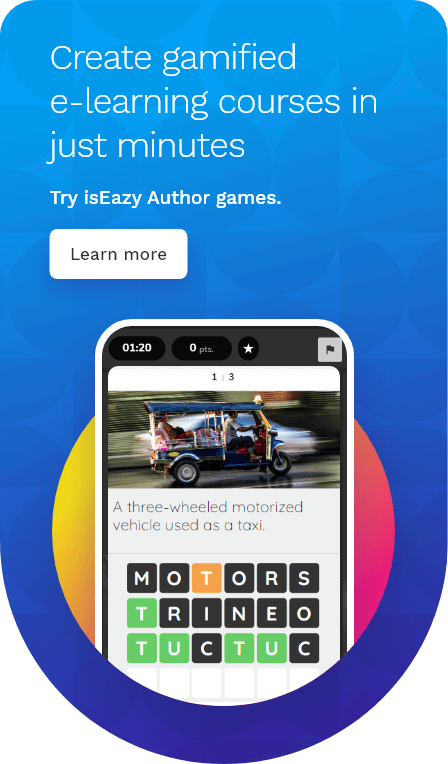Table of contents
ToggleOne of the most important elements of any e-learning course is its content. In fact, the success of a course depends directly on choosing that content correctly. In order to get this choice right, a set of specific variables must be taken into account. These variables can be shaped and adapted according to the audience your content is aimed at, which will help you to build greater student commitment and, as a consequence, enhance course completion rates.
Today, there is a wide range of e-learning content available for you to choose from. In this article, we’ll explore the main types, and discover which ones promote a higher level of student engagement. Keep reading to learn more!
The most popular types of e-learning content
E-learning courses have evolved dramatically in recent years. In particular, interactivity and gamification have emerged as key elements in designing a full and enriching learning experience.
Although creating content such as games and interactive exercises can sometimes be a challenge, there are tools that make the job easier. This is the case with isEazy Author, our authoring tool, which allows you to develop e-learning content with ease and agility – even without prior experience. You won’t need to be an expert to develop an impressive and rewarding course! But what type of content can you create with isEazy Author?
Basic interactives
Simple elements such as text, links or cards help students to absorb and contextualize course information. Moreover, features such as images and galleries allow them to understand more complex abstract concepts in a much simpler way.
Graphics
Graphs and percentages allow important numerical data to be represented in a more visual way.
Advanced interactives
The basic examples of e-learning content above will allow you to turn an otherwise flat e-learning course into an enjoyable interactive experience, but you can still go one step further.
Advanced interactives offer an even greater level of interactivity, allowing students to become the protagonists of their own learning. They make it possible for you to design a variety of scenarios and exercises. With isEazy Author, you can include three types of advanced interactive:
- Hotspots or points of interest. These pinpoint important elements within an image and provide complementary information.
- Linked scenes. Images with different navigation elements that allow you to interact with the content.
- Infographics. These display data in a visual way that allows information to be more easily understood.
- Embedded. Embedding allows you to host content from other websites, complementing any information your course already contains.
Multimedia elements
According to Edgar Dale’s learning pyramid, when we see something (such as a visualization) we remember 10% more of the information contained than if we read it.
Although written information is undoubtedly important, users tend to prefer (by up to four times more) video content, over simply reading an article that covers the same topic. Including video content in an e-learning course allows you to condense the information you want to present, and explain complex topics in a simpler, more visual way. All of this builds greater student engagement and adds dynamism to the course. But be careful – not everything goes!
It’s important to use well-chosen, concise videos to convey the key points of your knowledge. This way, you’ll keep hold of your employees’ attention, and help them maintain an active interest in the content. Use video to highlight important pieces of information, and ensure that they last no longer than five minutes, to keep attention focused throughout their duration.
Interactive videos
Interactive videos are a resource that strengthens the effect of audiovisual pieces, since they allow you to feature complementary concepts during playback. These interactions can make videos an even more enjoyable experience, focusing the student’s attention by helping them to become an active part of the visual learning. Including these interactives in your courses is easy – simply decide when you want them to appear.
Questionnaires
Quizzes or assessments are a fundamental part of any e-learning course. They allow students to check how well they understand the content, by receiving instant feedback. This way, they can get to know what they’re doing well, and what they need to work on. Questionnaires also allow your employees to better retain information gleaned from your e-learning courses, and effectively apply it to their work.
Exercices
Along with games, these are one of the most attractive elements for students, since they allow them to apply what they have learned in a practical and enjoyable way. In isEazy Author you can find the following exercise types: ABC, Group, Match, Sort and Complete.
Games
Gamification has led to a paradigm shift in e-learning. In fact, it has been proven to be one of the most effective strategies to improve employee engagement. Including games in e-learning courses makes the experience much more enjoyable for students and, therefore, increases participation rates and stimulates knowledge retention. isEazy Author offers the following game options:
- Wordle. Guess the word by discovering correct letters over 6 attempts.
- Donut. This game asks students to guess words related to their training, by using a single letter of each word and a brief description of it.
- Memory. A game in which cards are flipped and remembered in order to connect them.
- Trivia. An adaptation of the popular board game where you have to guess words by category.
- Swipe. A game based on sorting cards into two different categories.
E-learning content that builds greater engagement
According to a study carried out by “eLearning Industry”, interactive content increases knowledge retention by 50% when compared to traditional content. What’s more, students generally perceive these elements as more interesting and motivating, resulting in more enriching training. But, despite this, is interactive content the most commonly used content?
The most common content in e-learning
Assessments and evaluations stand out as the most commonly used content in the world e-learning. Without question, they are a highly useful resource, allowing students to measure their performance and determine which points they need to work on. However, it is also important to include other interactive elements, as the table below illustrates:
| Content type | Usage percentage based on content type |
| Assesments/evaluations | 36% |
| Video | 34% |
| Interactives | 10% |
| Documents | 7% |
Completion rates of e-learning courses
Including different types of interactives directly influences the completion rate of a course depending on which type is used:
| Content type | Completion rate |
| Assesments/evaluations | 74% |
| Video | 65% |
| Interactives | 62% |
| Documents | 62% |
As we’ve highlighted, the highest completion rate is achieved with assessments and videos. Next come interactive elements and documents (yielding even completion rates).
Tips for organizing your e-learning content
Including attractive content in an e-learning course is of little use if it isn’t structured correctly. A good structure allows the student to acquire the key concepts of the course in a logical and orderly fashion. This sequence is fundamental if the training is to be successful.
How to organize your e-learning content
As we’ve stated, structure is vital if you want to engage the user in the learning process. Although there are many ways to organize a course according to context, following the basic structure below will help you to stay on track:
- Introduction: Give context to the content that students will work on during the course.
- Objectives: Explain what students will achieve by completing the course.
- Outline: Give structure to the course content in an organized fashion. By providing a clear content outline, you’ll prepare your audience for what’s to come, and help your audience stay the course.
- Conclusions: Encourage students to reinforce key ideas from the content they’ve just worked on.
- Questionnaires/assessments: Allow students to measure their level of performance.
Types of content structure
If you’re currently in the process of developing e-learning content for your online course, there are two structures you should familiarize yourself with:
- Linear or sequential structure
In this information structuring system, the content that makes up your online course has a rigid and established order. The information contained within each block is directly related to (and dependent upon) that of the previous block, so that the student must advance to continue learning.
Typically, in order to ensure that this learning order is being followed, a system is integrated that prevents movement from one block to another unless a specific task has been first completed. Another option is simply to publish content blocks sequentially, so that each can only be viewed from a certain moment onwards.
However, take care with this approach! We do not recommend including too many prerequisites, as these can limit students, demotivating them and causing them to drop out!
- Non-linear structure
In this type of course structure, flexibility is key. Students carve their own path through training, by choosing which modules they wish to begin at each moment.
You may be wondering exactly how students can do this. Well, in this case, online courses are fully adapted to the needs of students and the time they have available – each can choose when, how and what they wish to study at any given time.
Although content may be set out in a specific visual order, students will be able to jump from one module to another regardless of whether or not they have completed previous ones.
Develop your own e-learning content with isEazy Author
Creating an e-learning course and filling it with quality content can be a demanding task, but there are tools that make the job much easier.
isEazy Author is an intuitive authoring tool that allows you to create incredible learning experiences in just a few minutes. It offers a range of over 25 different types of interactives, to help you develop engaging and entertaining courses which make learning fun.
In addition, its new Artificial Intelligence features help to reduce course creation time, multiplying the productivity of your instructional designer. With isEazy Author’s AI solutions, you can easily and automatically create interactive games, exercises, and more.
Can’t wait to try it for yourself? Don’t hesitate – try it free now!
















